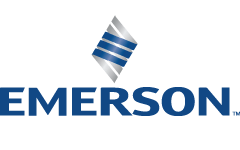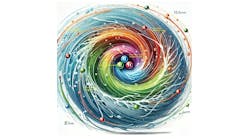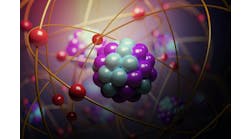Jim Smith set the bar for innovation sky high from the very start when in 1977 he led the team that brought the first mass flowmeter based on the Coriolis effect to the industrial market. Since that time, as Micro Motion and now as part of Emerson, Emerson, the organization has continued to break new ground. To talk about how Emerson has responded to changing industry demands, and what trends are likely to shape the company’s portfolio in the future, Keith Larson chats with Patrick Zimmer, director of product marketing for the company’s Coriolis portfolio.
Transcript
Keith Larson: Jim Smith set the bar for innovation sky high from the very start when in 1977, he led the team that brought the first mass flowmeter based on the Coriolis effect to the industrial market. Since that time, as Micro Motion and now as part of the Emerson, the organization has continued to break new ground, expanding the application envelope of Coriolis technology and making its industry-leading meters ever smarter and more capable.
Hello, this is Keith Larson, I'm the editor of Control magazine and ControlGlobal.com, and welcome to this Solution Spotlight episode of our Control Amplified podcast, sponsored today by Emerson. With me today, to talk about how Emerson has successfully responded to changing industry demands and what trends are likely to shape the company's portfolio in the future is Patrick Zimmer, director of product marketing for the company's Coriolis portfolio.
Welcome, Patrick, a real pleasure to talk with you today. Thanks for joining me.
Patrick Zimmer: Yeah, thanks. I appreciate the time and look forward to the conversation here.
Keith: Yeah, that sounds great. Well, I think going a little back to the start here, it seems that Micro Motion's early years were all about increasing performance of those meters, improving accuracy, stability of mass flow measurement, and even developing meters that were able to measure a broader range of diverse even multiphase flows. Can you speak a little bit about the innovations of the products over some of those early years and how some of the industry requirements have changed since then?
Patrick: Yeah, I think when you go back to the very first Coriolis meter that was part of the invention disclosure that Jim Smith made and kind of opening up the opportunity to using this technology in industrial markets, it was kind of a simple concept of using the Coriolis effect to measure fluid flow and getting that direct mass measurement, which really opened up a lot of new applications and how industrial markets really operated in measuring direct mass. If you think back to your first chemistry class, it was mass-based reactions, mass-based equations to get your product and yields, bringing that mass measurement into those markets really helped kind of change the game and simplifying it from a volume metric conversion and having to use densities and all of those other reference points. And our first Coriolis meters were really simplistic, but they also faced a lot of challenges.
Then technology advanced. If you think back to that timeframe, [it was] very much an analog device, so there wasn't a lot of outputs, how quickly we could do calculations weren't as quick as they are today. If we look over the history and what we've been able to do and how we evolved the performance of the sensors, it's been absolutely tremendous. And going from a single tube device that was referenced off of a very rigid, almost a concrete block that the meter was mounted to, you can now use dual-tube devices that can be mounted to freestanding pipes and measure wide range of products, some multiphase, and different ranges of temperatures. It's been absolutely amazing to see and being able to keep pace with the market and provide a more accurate, reliable measurement so they can improve their processes and their yield, and that's really what we're trying to do for our customers is to be able to take them to the next level of their operational performance.
Keith: Yeah, that makes a lot of sense because back in the day, Coriolis was always the kind of meter of last resort in some ways just because it tended to be more expensive than some of the old solutions. But I don't know that that was always the best solution to go with the cheaper meters, that's for sure.
Patrick: Yeah. Yeah, definitely.
Keith: Yeah. There also seems to be an era of Micro Motion real product innovation that really focused around the application context of the meter in use. I'm talking about the transmitter versions that increased application flexibility and onboard functionality, like smart meter verification to boost reliability. What have been some of the driving forces around not just the mass flow measurement, but this larger context of the applications and the applications that you could address with Coriolis technology?
Patrick: When I think about how we've expanded into application for specific industries, it really comes from a general process measurement and customers using this to measure flow on a continuous basis, or they're doing batching or something along those lines. But then, it evolved into something much bigger and all of a sudden it becomes a, "I want to use it for this and can you apply the software feature? Can we solve this other problem?" And I think one of our earliest ones was doing a concentration measurement, which is Coriolis meters measure mass flow, they measure a density and temperature. Well, by applying the density and temperature, we can provide you a concentration measurement. That was probably one of our very first kind of application-based features that we added within the transmitter, and onboard electronics enabled us to provide customers that concentration of a particular fluid that was flowing through the flowmeter and provide totals.
I mean, that has evolved into doing water cut measurement for oil and gas and being able to measure how much water and oil mixture's in there. And that has expanded into larger line sizes and bigger meters. Ultimately, I think one of the harder applications we do is our biggest meters being used for loading and unloading on high viscous fluids and major custody transfer lines that end up having to do a two-phase flow and a multi-phase condition. So, it's really kind of progressed over the years. And I think with the introduction of smart meter verification on top of that really helps customers build confidence. And are the meters working correctly? You know, going from a process measurement in an internal plant that's your own allocation, you have secondary controls or things you can look at, but if you're using this in a custody transfer environment, there's real dollars associated with that. You're making transactions off of it.
Our customers asked us, "How do we know if a Coriolis meter is still working? Is it still in calibration? Is it still meeting specifications?" And that's where adding these diagnostic tools, smart meter verification, really has helped us and helped our customers out to identify is a Coriolis meter still within its performance metrics. Does it look the same as when we calibrated it at the factory? I always think of it as a fingerprint, right? It's unique to every individual. We do a verification in the facility here and in the factory. Every meter has this and you look at it and they're all unique. They have their own fingerprints. If you want to change your fingerprint, you have to physically damage it, which sounds like maybe a gruesome example, but it really kind of rings true with the Coriolis meters, because if you change the meter in any way that fingerprint changes and it's going to behave differently, and then we know that it's out of performance. So, you know, kind of monitoring that has helped customers extend their calibration, being able to keep their meters in line and build confidence that they're working correctly, and it's helped improve their operation cycles and how they manage their equipment.
Keith: Yeah, that makes a lot of sense. I like the analogy of the tuning fork because it has a specific sound, specific note. And if you can test it and make sure that that note still has integrity, there's a high probability that everything is still working well, right?
Patrick: Yeah. That's probably a better example than the fingerprint one. I like the fingerprint one because every single one is very, very unique, but the tuning fork works the same. But we really do take a lot of care and in helping our customers out and making their lives easier out in the field.
Keith: Yeah. That makes a lot of sense. Higher operating temperatures and pressures is another way that or another frontier where your products have continued to push the limits based on customer demands, I'm sure. But with those sorts of conditions, safety is always an increased concern as well. How are you going about addressing these new extremes that they're pushing Coriolis meters to and how do you go about keeping safety first?
Patrick: Yeah, yeah. I'll address maybe the application space first and then I'll touch on safety, but we get these requests from customers and are looking at how their processes are evolving, how they're trying to improve their end yield and their production, and how they can be more efficient. Some ways they're doing that is increasing the operating pressures and temperatures and kind of identifying those needs and the line sizes and what fluids they're running and material compatibility is super important. So then we understand the limitations of those processes, so then we can go build the sensors to make sure that it meets their expectations and really we try to exceed those.
Keith: Yeah.
Patrick: So we do a ton of work here in our facility in Boulder, Colorado, to do a lot of our R&D testing. We have a global design team, but in Boulder, here we have every test I think that you could possibly run at a Coriolis meter, we try to do it here. Whether it's pulling at very high flow rates, environmental testing to see if it will survive various conditions, burst chambers, vibration shaker tables. We do everything we can to the meters, so when we put them out in the field we know that it will meet those specifications, those performance envelopes, those high pressures. So, we really do focus and we take safety very seriously in how our products perform and how they operate. Because as you increase pressure, as you increase temperature, those safety margins become kind of tighter and you have to really focus on making sure that it's a really reliable product. So, we do a lot of finite element modeling to ensure the design is appropriate, as well as all that physical testing, I think at the end of the day. And it's really impressive to see how much work goes into it. Our metallurgy experts will cut meters open and look at the inside to make sure welds are holding up and we've done everything we can to ensure that it's going to meet those specifications.
Keith: Yeah. It makes a lot of sense. I'd be remiss if we didn't talk a little bit about the increased focus around data and connectivity which has been, I think, all we've talked about for the last five years I think. What has Micro Motion been doing to really leverage the power of data analytics on behalf of its users?
Patrick: Yeah. I think if we look a little further back, Coriolis meters can be these data machines because they provide continuous digital output of mass flow rate, density, temperature, and a whole host of other diagnostics, and really utilizing it more than just a totalizer to say, how much should I flow in a particular day? How much oil or product that came out of this particular process? Looking at the continuous data has really opened up a new frontier for us to help our customers out. And this is something we do from when they call in and ask for help or looking for ways to improve their operations, but bringing data to the forefront and helping our customers out has really been a key theme for us and looking at how we can evolve our products to support that. So, when we introduced the 5700 field transmitter a few years ago, that was kind of at the forefront is, how do we make the data more accessible? How do we make it easier for our users to be able to look at it and really diagnose and improve their processes?
Coriolis meters measure what comes through them. If you don't use the information, you're never going to change your process. So, really giving them the data and building off of that. So the 5700 stores a massive amount of data, 30-day one-second data historian and can store years of five-minute average data that's included inside of it. So, you can plug in a USB in the side, and recently we've introduced a WiFi module that you can put on the front display, connect to it with your PC wirelessly or a tablet, download that data, and very quickly diagnose what went on. We've got a process phase which is a tool that allows you to graph the data and see all the alerts and everything associated with a real-time clock so you can associate something that occurred in the process in the past with something else in your plant or outputs or whatever else may have occurred. So, it's really providing a lot of that insight into the process with that data historian. And that's something we're including in all our future revisions of product is being able to build in that capability of looking back and diagnosing what exactly happened in the past.
Keith: And it certainly with the WiFi connection, certainly consistent with that whole NAMUR open automation model where you have this kind of second path, you still got your primary process variable that's maybe going into your control system, but you've got this whole second highway for all this diagnostic information to look at not only the meter but also diagnosing process problems and that sort of thing. So, that makes a lot of sense.
Patrick: Yeah. And, you know, I think their kind of original intent was when you think of, if you had to go to a meter that's in a remote location, and you could be able to access the information from a nice warm truck or your car without having to get outside and trudge through the snow or something. But certainly playing into the plant environment as well as creating those multiple paths for information, one for the control system, and then one for data analytics and going to the cloud and providing those multiple pathways for that rich content that comes out of the Coriolis meter for post-processing and all those data mining, and how all those customers are using it to really, creates second order of changes and their processes, not just a top-level improvement.
Keith: Yeah. That makes a lot of sense. Are there other new demands and maybe some emerging application areas that are shaping the next generation of Coriolis technologies that we'll see in the future?
Patrick: Yeah. You know, I think there's a lot of changes that we're seeing in the industrial environment. There's a lot of push for higher levels of efficiency of plants and how they operate, running at a better throughput, less downtime and safer. So, we are constantly thinking about how we can improve our product safety notifications from the products to ensure that our users are seeing what's happening in real-time. They can act on that, they can provide improvements and all of our safety certifications that are associated with that as well. In addition, we're seeing new trends with how Coriolis technologies are being applied, and a big trend in Europe that we're seeing, and frankly, it's becoming more and more global by the day, is looking at hydrogen as an alternative fuel for vehicles. And we've recently designed a high pressure, very small Coriolis meter to fit in those dispensers, similar to a gas station to be able to fill hydrogen fuel cars.
And it's really kind of a cool process, if you think of casing hydrogen from whatever source it may be as a by-product from a production facility or electrolysis from renewables, there's multiple avenues for how hydrogen is going to be produced and there's a huge value chain associated with that. But ultimately, getting it into a vehicle and really they're driving the same experiences, filling up a car so being able to fill a car with gasoline. So, it's very similar driving that adoption, and it's very interesting to kind of track that we're certainly working on. We've released one meter and we're looking at how that can apply to larger vehicles as well. Just as much as our passenger cars.
Keith: I can imagine airplanes or other vehicles that don't lend themselves as easily to battery power being really key growth areas for this technology.
Patrick: Yeah. Planes, trains, and automobiles I mean, it's kind of interesting to think of a plane flying, doing a flight based on that but they are certainly trying it out and it's been super interesting to see how that technology has advanced very quickly in the past couple of years here and how adoption may be growing very fast as well. And we're always looking for ideas and how we can push the technology. I mean, we handle everything from flow meters that measure a drop an hour all the way up to 120,000 pounds a minute and a 14-inch line size. So, everything in between from a general process, you know, on that very small scale, but we're always looking and customers come to us because we're able to build very unique products. And what if we could do this with the Coriolis meter? What if we did this other thing over here? Can you increase the pressure? Could you make it smaller? Could you make it this shape? And we're looking for those unique challenges to continue to push Coriolis technology and its applications in use really to help our customers meet their goals, meet their production targets, and improve their processes at the end of the day. Because if they use less product that may be dangerous or hazardous or whatever it may be, that's better for everybody and producing a better final product on their end as well.
Keith: Yeah, that makes sense. Have to think what Jim Smith would think if he saw, if he went to a future gas station that had hydrogen and one of his little sensors embedded within a consumer-facing device, which I think is really fascinating because I was thinking of this being very industrial, but this is very much even a consumer side thing. I wonder what he would think of how far you've come.
Patrick: Yeah. I think he'd be pretty interested in, you know, it's kind of amazing that the scale too of going from the original meters that were made and I almost kind of imagined some of them look like a very big textbook, right? And then having a meter that's 14 inches and then one that's the size of a deck of cards almost to measure that drop an hour and how we've evolved from an analog device to very digital, and having Ethernet and wireless connectivity strategies. Even looking at our 4200 two-wire Coriolis meter and be able to run a Coriolis meter on a very low power, I think he'd be kind of surprised by that and how we've been able to leverage technology advancements and computers and chips to apply that to industrial tool is really been fascinating. And, I've been working for Emerson for 11 years now and never thought I'd be working for Coriolis meters for 11 years, but there's always something new that comes up and piques interest and how we continue to innovate and bring new technology features to our customers.
Keith: Yeah. Well, it's exciting to hear the story of the past, and I'm excited to see what the future holds as well. Congratulations on all that you've accomplished and best of luck from here going forward.
Patrick: Yeah, absolutely. I appreciate the time today. And I certainly think we're going to continue to bring new innovative products to the market and look forward to sharing those with you and in the near future here.
Keith: Well, I have to say, thanks so much, Patrick, for taking the time to share your insights with us and with our listeners today. Thanks also to Emerson for sponsoring this episode.
I'm Keith Larson, and my guest today has been Patrick Zimmer, director of product marketing for Emerson's portfolio of Coriolis meters. Thanks again, Patrick. And for those of you listening, thanks for joining us for this Control Amplified podcast. If you've enjoyed this episode, you can subscribe at the iTunes Store or Google Podcast. Plus you can find the full archive of past episodes at controlglobal.com. Thanks again, Patrick, really appreciate it and signing off until next time.
For more, tune into Control Amplified: The Process Automation Podcast.





